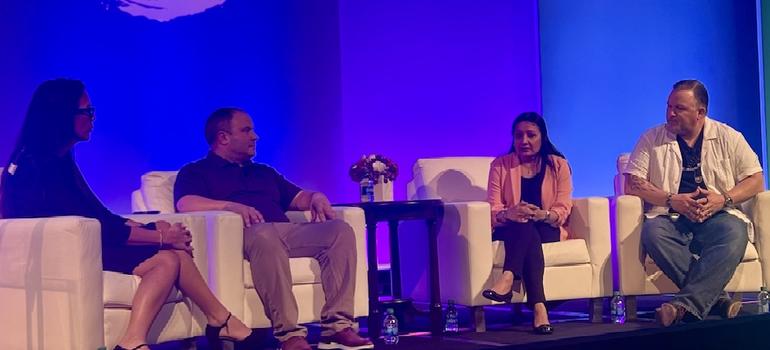
Photo Credit: CUToday.info
(From CUToday.info) LAKE BUENA VISTA, Fla.–Is AI a fantasy or a frontier for credit unions?
According to three experts here, it’s a frontier, and some big changes are already underway, meaning credit unions and CUSOs need to have strategies in place for not just themselves, but their partners.
The issue was discussed during the NACUSO Network meeting on what was called “Transformation Thursday,” as part of one of Mitchell Stankovic’s Underground discussions.
Participating in the panel were Randy Stolp of Synergent, Asha Connors of Trellance, and Steve Castagna of AKUVO. The discussion was moderated by Brandi Stankovic.
Stankovic: Is transformation a fantasy or a frontier?
Castagna: We are looking at AI on two paths. One is modeling, machine learning and behavior, and how do we make sure we are efficient and how do we ensure the information we are using as a tool creates efficiency.
The other area is the conversational piece. We look at ‘How do we make sure it gives us the right conversation?’ We are forming pilot groups now to make sure we can trust it. We don’t want to take a step back. We want to make sure members say, ‘This is a much better experience.’ This is where the frontier is going, but you have to be cautious.
Connors: The financial landscape is changing. Credit unions are going to be faced with the challenge of understanding and employing their data to good use, so they can draw from the data they already have to drive growth, to improve their member experiences, and also become competitive.
AI and data analytics are right in the middle of that journey right. I think that’s something that we need to invest in, but the challenge is you need to have the right balance. If you don’t already have the expertise or you’re still in the beginning of your data journey, you need to bring the right talent in to help you on this journey. That’s where external talent providers with specialized talent and knowledge can help you.
Stolp: I think it’s both. I’ve long said, ‘People are the best technology.’ If we don’t have the people right then nothing else matters. The challenge right now is finding that intersection between people and technology.
It’s different for everybody. That’s the tough part. It’s not one size fits all. You can’t just pick this up and do it the same way. You really have to consider the people part and use the technology to enhance people.
I was one of the slowest CIOs in my previous role to embrace ChatGPT and generative AI, because I had (questions around applicability) and trying to think through that intersection of people and technology.
Stankovic: Do we risk losing touch with people who know the credit union business?
Connors: We pride ourselves at Trellance on being a credit union co-op. We bring the credit union expertise and talent that comes from credit unions. That’s our differentiator. When we hire new people, if they don’t have the experience, we train them in all things credit union. At the end of the day we are here to help credit unions succeed to serve their members better.
Stolp: We think it’s critical in our onboarding process to bring our people into the credit union culture to help them understand what it means to be part of a CUSO and be part of a credit union sand to serve these communities.
Stankovic: What trends should we be focused on?
Castagna: This is going to be transforming this industry over the next five-10 years. We look at it as there’s such a hard time getting good talent and bringing them up correctly, so how do we make sure we have the right technology to allow them to do what they need to do. How do you make sure that you bring good people up and give them the tools necessary. I think this transformation of AI is so cool, but right these are the early stages.
Connors: There are new regulations coming in every day, so keeping an eye on that. Make sure with the tools and the technologies you have that you have the skillsets to support those.
Make sure you have a good plan and a good strategy. Does this actually meet your goals or your objectives? Don’t just bring in technology for the sake of it because somebody else is doing it. How does this help me? How can I do it in a way as to be societally responsible?
Provide the support, give the training, make sure there are continuous learning opportunities for your staff. Make sure you have the right partners that actually keep your interests at heart and want to see succeed. They are going to be an extension of their team.
Stolp: The transformation side has already happened, but we need to continue to evolve as we transform. The most important thing to me is the intentionality of it. Plan, and don’t just sit back and let these things happen to you.
Castagna: You have to try things. Have a plan in place so you know what you’re doing. But try things.
Stankovic: How do we tell these stories?
Stolp: We have to get better at tracking them. We have to establish some baseline and then some metrics around what we intend these things to accomplish. And we need to track them for our credit unions.
Castagna: Just start with some baseline data and then evolve from there. It’s challenging to determine what is the intended consequence.
Stolp: The best stories have people and numbers in them.
Connors: I want to look at the other side, too. There is a general perception AI will reduce jobs, so there is fear. Bringing in empathy to your people so they understand these tools are here to help you do your job better. It removes the tedious side of the house and frees you up to interact with members and help that much better.
Get your staff also involved in that process. At the end of the day, it’s about helping everyone to succeed.

